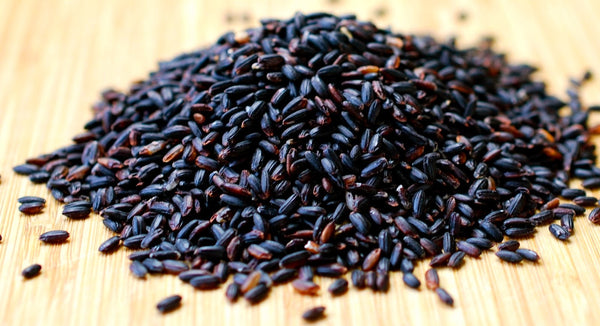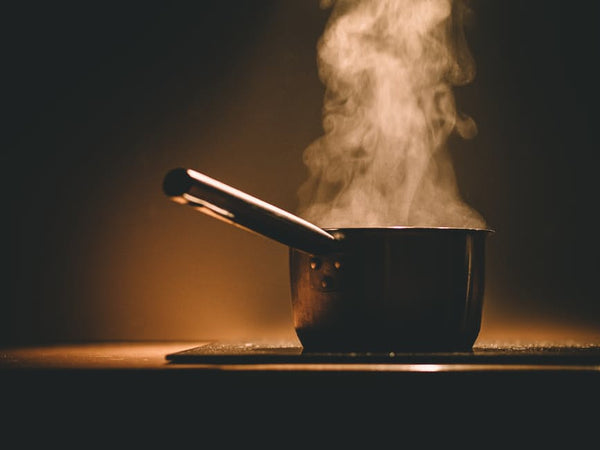Ever wonder what makes an eggplant dark purple or what gives blueberries and acai berries their deep rich color? The culprit is Anthocyanin. Say it with me: An-tho-cy-a-nin. Anthocyanin deserves recognition for its antioxidant properties and is found in a variety of foods, including forbidden rice.
Black rice, more interestingly referred to as forbidden rice, has been a feature in Asian diets for thousands of years and is valued for its rich antioxidant quality. Legend has it that noble Chinese men took every grain of black rice into their possession, banning its consumption for those who were not royalty, hence the name Forbidden Rice. Although black rice is no longer forbidden, it’s still grown in smaller quantities compared to other rice varieties, and it wasn’t available in the West until the early 90s.

Benefits of Forbidden Rice
It’s said that a spoonful of black rice bran packs in more anthocyanin antioxidants than a spoonful of fresh blueberries—but with less sugar and more fiber and vitamin E. While that would be equivalent to about 10 spoonfuls of forbidden rice, that’s still much more than other rice varieties.
Here are some more benefits to be gained by adding this treat to your weekly menu:
Rich in Antioxidants: The outer bran of forbidden rice has one of the highest levels of anthocyanin antioxidants found in any other grain. These specific antioxidants have been found to protect against cancer from free radical damage, improve heart health, and reduce inflammation. To top it off, black rice also contains Vitamin E, another powerful antioxidant important for skin, eye, and immune health.
Naturally High in Minerals: Forbidden rice is loaded with beneficial minerals including: magnesium (20%), phosphorus (20%), zinc (8%), and iron (6%).
Good Source of Fiber & Protein: Forbidden rice has more fiber and protein than all other rice varieties. Here’s how they all compare:
Rice Comparisons for ½ cup serving (2)
|
Type |
Fiber |
Protein |
Iron (%DV) |
|
Black |
4.9g |
8.5g |
3.5% |
|
Brown |
2.8g |
7.9g |
2.2% |
|
Red |
2.0g |
7.0g |
5.5% |
|
Polished White |
.6g |
6.8g |
1.2% |
Where to Buy Forbidden Rice
While the knowledge and awareness of forbidden rice is growing in the U.S., it’s still less popular than white or brown rice, even though it has 6x as many antioxidants. In order to take advantage of the valuable nutrients in this delicious, nutty rice, make sure to get 100% whole grain black rice, as most of its benefits are lost when removing the outer layer.
Lotus Foods Organic Forbidden Rice is my favorite. It can also be found at Whole Foods. I don’t recommend buying this on Amazon unless you're buying in bulk. Single packets are double the price!

How to Cook Forbidden Rice
Forbidden rice takes a bit longer to cook as it’s thicker and unrefined. I recommend soaking the rice for 45-minutes to 1-hour for a softer rice and to speed up cooking time.
- Method
- Place 2 parts water to 1 part rice in a small pot (1 cup makes 3-4 servings—so enough dinner for my husband and I plus lunch for me the next day.
- Bring to a boil.
- Reduce heat to low, cover, and cook for 30-minutes.
- Remove from heat and leave cover on to let steam for another 10 minutes.
- Remove cover and fork through to fluff.
- Tip: If you don’t have time to soak the rice, boil it a little longer. If it starts to dry out, add some water and continue to simmer until it reaches the desired softness (about 5-10 minutes).
Cooking Tips to Reduce Arsenic Intake from Rice (per the EWG)
Know the Origin of your Rice: Rice grown in Southeast Asia and California tend to be lower in arsenic than other countries.
Rinse and Wash: Always rinse your rice with cool water until the water runs clear before cooking. I typically wash my rice 3-4 times, soak for an hour, then drain and add fresh water before cooking on the stove.
Limit your Intake: As with all things, even good things, everything in moderation is key. For healthy adults, the EWG recommends 1-3 servings of rice-based foods/week. For kids, ¼ serving. Tip: Try replacing rice-based cereals with pureed bananas, squash, and sweet potatoes to help balance it out.
To learn more about arsenic in rice and rice-based products visit the EWG here.
Forbidden Rice Recipes
Forbidden rice can be substituted for white, brown, or red rice in most recipes but here are two of my favorites :)
Tofu with Stir-Fried Vegetables over Forbidden Rice (adapted from Minimalist Baker)
- Ingredients (makes 2-3 servings)
- Stir Fry
- 1 14-ounce package organic non-GMO firm or extra firm tofu
- 2 cups roughly chopped organic green beans
- 1 cup diced organic red pepper
- 2 Tbsp toasted sesame oil for sautéing (or sub coconut oil)
- Sauce
- 1/4 cup low-sodium organic soy sauce (or sub gluten-free Tamari)
- 1 Tbsp fresh grated ginger
- 2 Tbsp organic brown sugar
- 1 Tbsp arrowroot flour to thicken (optional)
- Tip: I like to add a little water to the sauce to help balance the saltiness of the Tamari
- Method
- Preheat oven to 400 degrees F and begin drying your tofu. Drain, remove it from the package and place between two thick towels.
- Let it dry for about 15 minutes then chop into roughly 1-inch cubes.
- Arrange tofu on a baking sheet and coat with a little oil, salt, pepper and soy sauce/tamari to prevent sticking and help the flavors sink in. Bake for a total of 25-35 minutes, flipping once halfway through to ensure even cooking and to prevent sticking.
- Start the rice at this point (see instructions above)
- In a small mixing bowl, whisk together all of the sauce ingredients and set aside.
- To a large skillet over medium-high heat, add sesame oil and swirl to coat. Then add veggies and toss to coat. Cook for 5-7 minutes, stirring often. When the vegetables have some color and have softened a bit, add the sauce and stir. It should bubble and thicken. Then add the tofu and stir to coat.
- Cook the mixture for 5 minutes, stirring often. When veggies are cooked to your preferred doneness, remove from heat and serve over forbidden rice.
- Tip: Top with crushed red pepper flakes or Sriracha for a little kick.
Coconut, Mango, Kiwi Forbidden Rice Pudding
- Ingredients (makes 2 servings)
- 1/4 cup uncooked organic forbidden rice
- 2 cups light or regular organic coconut milk
- 2 cups water
- 2 tbsp maple syrup
- 1 mango, chopped
- 1-2 kiwis, chopped
- Method
- In a medium saucepan, bring rice, water, coconut milk and maple syrup to a boil.
- Reduce to simmer and cook for 30-40 minutes until rice is tender.
- To serve, divide pudding (chilled or at room temperature) into bowls and top with fresh mango and kiwi
- Tip: Sprinkle some shredded coconut and a drizzle of maple syrup on top for some extra sweetness ;)
Love + Light,
Smita :)
